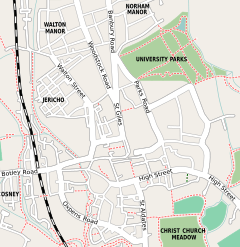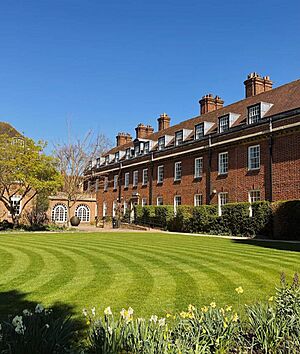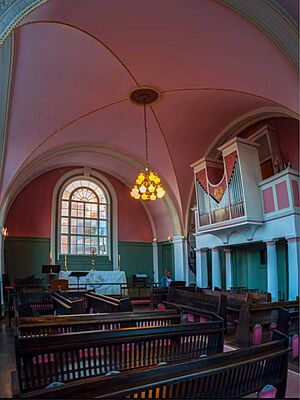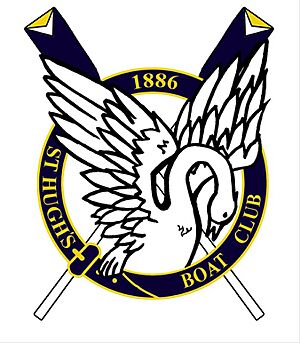St Hugh's College, Oxford facts for kids
Quick facts for kids St Hugh's College |
|||||||||||||
|---|---|---|---|---|---|---|---|---|---|---|---|---|---|
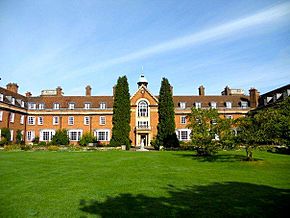 |
|||||||||||||
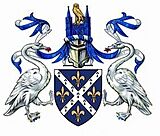
Blazon: Azure, a saltire ermine, between four fleurs-de-lys or.
|
|||||||||||||
|
|
|||||||||||||
| University | University of Oxford | ||||||||||||
| Location | St Margaret's Road, Oxford OX2 6LE | ||||||||||||
| Coordinates | 51°45′56″N 1°15′48″W / 51.765675°N 1.263406°W | ||||||||||||
| Full name | St Hugh's College in the University of Oxford | ||||||||||||
| Latin name | Collegium Sancti Hugonis | ||||||||||||
| Established | 1886 | ||||||||||||
| Named for | Saint Hugh of Lincoln | ||||||||||||
| Sister college | Clare College, Cambridge | ||||||||||||
| Principal | Lady Elish Angiolini | ||||||||||||
| Undergraduates | 420 (2017/2018) | ||||||||||||
| Postgraduates | 377 (2017/2018) | ||||||||||||
| Boat club | St Hugh's Boat Club | ||||||||||||
| Map | |||||||||||||
St Hugh's College is one of the colleges that make up the University of Oxford. It is located on a large site (about 14.5 acres) on St Margaret's Road, just north of Oxford city centre. The college was started in 1886 by Elizabeth Wordsworth as a college only for women. It started accepting male students in 1986, 100 years after it began. St Hugh's is well-known for its beautiful, large gardens.
In 2011, when the college turned 125 years old, it officially became a charity. By July 2018, the college had about £37.6 million in its special fund to help run things.
Contents
History of St Hugh's College
How St Hugh's College Started
St Hugh's College was founded in 1886 by Elizabeth Wordsworth. She was the great-niece of the famous poet William Wordsworth. Elizabeth wanted to create a place where women who didn't have a lot of money could live and study in Oxford. She also wanted the college to have religious teachings, similar to another college called Lady Margaret Hall.
Elizabeth used money left to her by her father, who was a bishop. She opened the new college at 25 Norham Road in North Oxford. She named it after Hugh of Lincoln, a bishop from the 12th century who became a saint. Oxford used to be part of his church area.
Early Years and Growth
At first, the college used several buildings in the Norham Road area. The first head of the college was Charlotte Anne Moberly. Early students included Jessie Annie Emmerson and Charlotte Jourdain. Students had to ask the principal before visiting friends, and the college gates closed at 9 PM. Rent for a room was about £18 to £21 per term, with extra charges for fires.
In 1913, the college began to move to its current location. It bought a house called "The Mount" for £2,500. This house was later taken down to build the college's Main Building. This new building was built between 1914 and 1916, thanks to a gift from Clara Mordan. The college's new library was named Mordan Hall in her honour. The first book in the library was a copy of the Koran, given by the Bishop of Tokyo. In 1919, J. R. R. Tolkien, who wrote The Hobbit and The Lord of the Rings, started teaching students at St Hugh's.
The college continued to grow, buying more properties nearby. It gained full ownership of its main site in 1927. In 1926, the college received a special royal charter, which made it an official part of the university system.
In 1936, for its 50th anniversary, a painting was made of the principal and some tutors. In the same year, a new library was built and named the Moberly Library. This library was later updated and renamed the Howard Piper Library in 1999-2000.
St Hugh's College During World War II
When the Second World War started, the college was taken over by the military. It became a special hospital for head injuries, treating over 13,000 soldiers and women between 1940 and 1945. Doctors at the hospital made big improvements in treating brain injuries. The college's staff and students had to move to other places during the war.
After the war, in 1945, the college buildings were returned. The temporary hospital huts were used as offices for a while before being removed in 1952. In 1948, Agnes Headlam-Morley, a teacher at St Hugh's, became the first woman to hold a full professorship at the University of Oxford.
Development After 1945
In the 1950s, St Hugh's bought more land, eventually owning the entire 14.5-acre site. The Main Building was expanded in 1958.
The 1960s were a busy time for building at St Hugh's. The Kenyon Building was built between 1964 and 1965 to provide more student housing. This was followed by the Wolfson Building, built between 1966 and 1967. It was opened by Princess Alexandra and Harold Macmillan, who was the university's chancellor.
The college chapel was updated in 1980, and a new organ was put in. Several houses on Woodstock Road were also renovated. These houses are now named after three people from Hong Kong who gave money for the renovations.
St Hugh's Becomes Co-educational
For many years, St Hugh's was a women's college. In the 1970s, some Oxford colleges started allowing both men and women. In 1980, there was a discussion about St Hugh's also becoming mixed, but it didn't get enough votes at first. The college principal, Rachel Trickett, was against it for a while. However, in 1986, it was finally decided that St Hugh's would start accepting male students. When Rachel Trickett retired in 1991, the first male principal, Derek Wood, took over.
A new boathouse was built for the St Hugh's Boat Club between 1989 and 1990. This was followed by the Rachel Trickett Building, completed in 1992.
St Hugh's College Today
Between 1998 and 2000, the Maplethorpe Building was constructed. It has meeting rooms on the ground floor and student rooms on the upper floors. A new main entrance was also built on Canterbury Road.
The college library was greatly improved between 1999 and 2000. It was renamed the Howard Piper Library after a former student. Another older library, Mordan Hall, was also updated in 2007 and renamed the Patrick Byfield law library.
There are statues of both St Hugh and Elizabeth Wordsworth on the library stairs. These were given to the college in 1936. St Hugh is shown holding a model of Lincoln Cathedral and resting his hand on a swan. Elizabeth Wordsworth is wearing her special robes.
In 2011, St Hugh's College celebrated its 125th anniversary with a big garden party. Aung San Suu Kyi, a famous former student, sent a message saying how much she loved her time at St Hugh's.
In 2012, the college faced a legal challenge about its policy of requiring students to show they had enough money for living costs. The college said this was to make sure students could finish their studies. The issue was later resolved, and the university changed its policy to be less strict.
Recent Developments
In 2008, the college started raising money for a new building. In 2010, a businessman from Hong Kong, Dickson Poon, donated £10 million for the Dickson Poon China Centre. This centre houses the university's China Studies department and provides rooms for postgraduate students. It also has The Wordsworth Tea Room. Prince William opened the Dickson Poon building in September 2014.
Buildings and Location
St Hugh's College is located on a rectangular site in North Oxford. It is surrounded by Banbury Road to the east, Woodstock Road to the west, St Margaret's Road to the north (where the front entrance is), and Canterbury Road to the south (where the back gate is). The college gardens cover about ten and a half acres.
The main entrance leads into the Main Building, which has student rooms, teaching areas, the chapel, and the dining hall. Most first-year students live in the Main Building or the Kenyon Building. Some first-years also live in the Maplethorpe and Mary Gray Allen Buildings, which are mostly for second-year and final-year students. The Rachel Trickett Building and 82 Woodstock Road are used for second and third-year housing. The Wolfson Building is mostly for second-year students. There are also rooms for final-year students in houses on Banbury Road. All student rooms have access to a kitchen. Most students share bathrooms, except in the Maplethorpe and Rachel Trickett Buildings, which have private bathrooms.
The Wolfson Building became known for having frequent maintenance problems. In 2018, after rats were found in the building, the college got two cats, Admiral Flapjack and Professor Biscuit, to help. Since 2019, the cats can roam freely around most of the buildings.
College Funds
As of July 2018, St Hugh's College had about £37.6 million in its special fund. This was one of the smaller funds among Oxford colleges. For example, St John's College had a fund of £551.5 million.
Student Life at St Hugh's
The college is large enough to provide housing for all its undergraduate students throughout their studies. There are three big lawns that students can use all year. The gardens are also a popular spot for playing croquet. Students can join many different clubs and societies, including sports, academic groups, and groups for special interests like gardening.
The college has a formal dinner called Formal Hall once a week. It's a three or four-course meal served with wine. Students wait for the senior members of the college to arrive at the High Table. Before the meal, a special blessing is said in Latin.
Junior Common Room (JCR)
Like other Oxford colleges, the undergraduate students at St Hugh's have a committee that represents them, called the JCR Committee. "JCR" also refers to the common room where students can relax. The JCR used to be named after Aung San Suu Kyi, but in 2017, students voted to remove her name.
The Swan is a weekly newspaper written and managed by students.
Middle Common Room (MCR)
The college also has a Middle Common Room (MCR) for graduate students, located at 87 Banbury Road.
College Choir
St Hugh's has a choir that sings at a weekly Sunday service called evensong. The choir includes students from all parts of the college.
The current organ in the chapel was built in 1980. The college offers special scholarships for organ players and four choral scholarships each year. A professional organist helps with the chapel music.
St Hugh's College Boat Club
The St Hugh's College Boat Club (SHBC) is the rowing club for students at St Hugh's College. It is located on the River Isis in Oxford. The club's blazer is blue with white and yellow stripes on the cuffs and lapels.
History of the Boat Club
The St Hugh's College Boat Club has a long and interesting history, especially in helping women's rowing grow at Oxford. The club started a few years after the college itself, with the first record of a boat in 1891. Only students who could swim were allowed to use it. About 20 years later, the club bought its first boathouse.
After many years of building up its equipment, the club's training improved a lot. This led to the Boat Club winning the Inter-College Fresher's fours competition, showing its potential. However, the club later faced financial problems and had to stop rowing for a short time. A solution was found in 1953, and the club started again. But soon after, it lost its only race-worthy boat before an important race against Cambridge. The club wasn't mentioned again for a while, suggesting it struggled to recover.
The Boat Club was restarted in 1973, thanks to the efforts of Julia Winterbottom and others. The new club had 16 members and was coached by members of the Brasenose College Boat Club. They quickly became strong competitors. In 1975, the St Hugh's Women's First VIII (their top women's team) achieved something amazing: they managed to "bump" (overtake) a men's team from Magdalen College. This was the first and only time a women's boat successfully bumped a men's crew. This event helped lead to the creation of separate women's divisions for the annual Summer Eights rowing competition starting in 1976.
In 1979, St Hugh's W1 finally won the Boat Club's first Headship, meaning they were the top boat in their division. They couldn't hold onto it the next year, but they quickly bounced back. In 1982, with a very talented team, they won Headship again. They kept winning Summer Eights Headship until 1984. The Boat Club also won the Torpids Headship in the Women's division in 1986.
Summer Eights Wins
| Year | Result | ||
|---|---|---|---|
| 1979 | Women's Headship | ||
| 1982 | Women's Headship | ||
| 1983 | Women's Headship | ||
| 1984 | Women's Headship |
Torpids Wins
| Year | Result | ||
|---|---|---|---|
| 1986 | Women's Headship |
Other Rowing Victories
| Year | Regatta | Result | |||
|---|---|---|---|---|---|
| 1978 | Christchurch Novice Regatta | Winner of Regatta | |||
| 1984 | Christchurch Novice Regatta | Winner of Regatta | |||
| 1988 | Henley Women's Regatta | Winner of College Eights (Div B) | |||
| 2012 | Shrewsbury Regatta | M1 win M.NOV 4+ division | |||
| 2014 | Oxford City Regatta | W1 rower Janita wins W.IM3.1x | |||
| 2014 | Thames Ditton Regatta | W1 win W.NOV 8+ division | |||
| 2022 | Linacre Novice Regatta | Winner of Regatta |
Famous Rowers from St Hugh's
Some famous rowers from St Hugh's include American Olympic rower Anders Weiss. Oskar Zorrilla was the cox (the person who steers the boat) for Oxford when they won The Boat Race 2013. In The Boat Race 1982, Boris Rankov from St Hugh's won a record number of boat races as a rower.
People Connected to St Hugh's College
Principals of St Hugh's
| Years | Principal |
|---|---|
| 1886–1915 | Charlotte Anne Moberly |
| 1915–1924 | Eleanor Jourdain |
| 1924–1946 | Barbara Gwyer |
| 1946–1962 | Evelyn Procter |
| 1962–1973 | Kathleen Kenyon |
| 1973–1991 | Rachel Trickett |
| 1991–2002 | Derek Wood |
| 2002–2012 | Andrew Dilnot |
| 2012–present | Lady Elish Angiolini |
Famous Alumni of St Hugh's College
Many students from St Hugh's College have gone on to do amazing things in different fields.
In politics, Theresa May, a former Prime Minister of the United Kingdom, studied here. Other politicians include Nicky Morgan, a former Education Secretary, and Rachel Maclean (politician), a current UK Housing Minister. Barbara Castle, a former Secretary of State, and Khairy Jamaluddin, a Malaysian Government Minister, also attended. Aung San Suu Kyi, who won the Nobel Peace Prize, also studied at St Hugh's.
Emily Davison, a famous suffragette who fought for women's right to vote, studied at St Hugh's for a short time to take her final exams.
In the arts, the musician Joe Goddard (from the band Hot Chip) studied at St Hugh's. Conductor Jane Glover and BBC arts broadcaster Suzy Klein also studied music here. TV writer Richard Hurst wrote his first play at St Hugh's. Actress and comedian Rebecca Front started her career at the college. Writers like Mary Renault and Amal Clooney also attended.
In science and academia, Ruth Lawrence, a mathematical child prodigy, joined the college in 1983 when she was just 12 years old. Dorothy Bishop, a psychologist who studies developmental disorders, also studied at St Hugh's. Other academics include philosopher Gertrude Elizabeth Margaret Anscombe and mathematician Mary Cartwright. Another mathematician, Jillian Beardwood, known for her work on the "travelling salesman problem," graduated from St Hugh's in 1956.
In law, Heather Hallett, Baroness Hallett, a judge in the Court of Appeal, is a St Hugh's graduate. Human rights lawyer Amal Clooney also earned her law degree from St Hugh's.
Images for kids
-
Emily Davison, a suffragette who fought for votes for women
-
Barbara Castle, a former Health Secretary
-
Nicky Morgan, a former Education Secretary
-
Aung San Suu Kyi, a Nobel Peace Prize winner
-
Amal Clooney, a human rights lawyer
See also
 In Spanish: St Hugh's College (Oxford) para niños
In Spanish: St Hugh's College (Oxford) para niños


